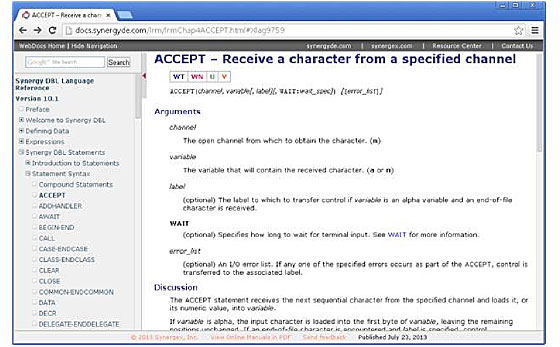Synergy documentation at docs.synergyde.com
Lambdas, virtual methods, Synergy XML API, snapshots, bitwise operators, constructors, ASYNC, system-supplied routines, VariantDesc, Select class, prototyping, garbage collection, data encryption, boxing…
The world of Synergy/DE encompasses a profusion of concepts and technologies. So when you want to find out about something related to Synergy development or you want to find out how to use something in Synergy/DE, where do you go? Often the quickest and most convenient way to learn about a Synergy‑related topic is to simply Google it. To make Synergy documentation more accessible to Web search engines, we publish five of our most popular Synergy reference manuals on the Web in HTML format:
Synergy DBL Language Reference Manual
Environment Variables & System Options
Synergy Tools
xfODBC User’s Guide
SQL Connection Reference Manual
These manuals are published as HTML pages wrapped in a navigation/search framework we call Synergy/DE WebDocs, and they are available at docs.synergyde.com. Synergy/DE WebDocs works with leading browsers on your desktop system or tablet, and it features an internal Google site search, TOC-style navigation, links for cross-references, and the ability to hide/show navigation features.
So whether you’re wondering how the ACCEPT statement works or want a primer on boxing, try searching for the word or phrase in your favorite search engine. If there’s too much noise (hits for pugilist rankings, Marquess of Queensberry rules, and the like), add “Synergy” or “Synergy/DE” to your search—e.g., “boxing Synergy”. This should bring WebDocs results to the top of the list. And if there is still too much noise (who knew there was a Synergy boxing team in Canada?), you can go straight to docs.synergyde.com and use the internal Google site search instead. With this search, results are limited to the docs.synergyde.com domain, so it’s easy to find what you want. And suppose you already know where the information is; suppose you know that ACCEPT documentation is in the “System-Supplied Subroutines and Functions” chapter of the Synergy DBL Language Reference Manual? In that case, simply go to docs.synergyde.com, click on the Synergy DBL Language Reference link, and use the TOC-style navigation pane to get to the page.

No matter how you get there, you’ll see the full documentation for ACCEPT or any other topic covered in the five published manuals. And you can view this information whenever and wherever you have access to the Web.
|